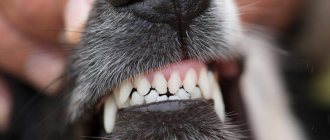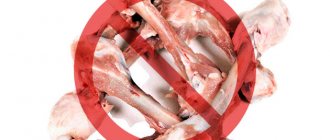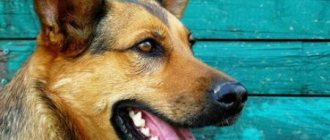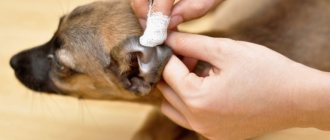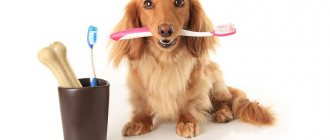Just like in children, dogs change their milk teeth to permanent teeth, with only one difference - by the age of one year the puppy turns into an adult dog. Most physiological processes, including the change of teeth in dogs, proceed at an accelerated rate.
Dog puppies are born with no teeth in the mouth - with bare gums - and by adulthood they have 42 permanent teeth.
During their lifetime, dogs have two sets of teeth - milk and permanent. Moreover, regardless of the dog’s breed, the replacement of milk teeth with permanent ones occurs in the same sequence; the only difference is in the timing of the change of teeth. There is such a pattern - in dogs of large breeds, unlike dogs of small breeds, the change of milk teeth to permanent teeth occurs faster.
Milk teeth in puppies
Puppies are born with missing teeth. They feed exclusively on mother's milk. The first milk teeth in puppies begin to appear 20-30 days after birth.
At the same time, in dogs of dwarf and decorative breeds, the first milk teeth appear at 1.5 months of age. With proper jaw development, puppies should have 28 primary teeth (14 teeth on the lower jaw and 14 teeth on the upper jaw). Of the milk teeth there are 4 canines, 12 incisors and 12 molars. The canines begin to appear first, then the incisors, and lastly the molars.
Permanent teeth in dogs
When the puppy reaches the age of 4-6 months, the dog’s milk teeth, like those of children, begin to change to permanent teeth. The replacement of baby teeth with permanent ones usually lasts two months and depends on the breed of the dog. At the same time, the number of permanent teeth that appear exceeds the number of milk teeth; the dog has 42 of them. All permanent teeth are divided equally into the upper and lower jaws, with the exception of molars, of which there are two more in the lower jaw.
The change of teeth in dogs is due to the fact that the rather long root of a baby tooth gradually dissolves, becomes weak and is pushed out by a strong, growing permanent tooth.
The first of the dog's permanent teeth to appear is the incisors, then at five months the molars (molars and premolars) appear; the last of the dog's permanent teeth to appear are the canines, first on the lower and then on the upper jaw. The complete replacement of milk teeth in dogs should be completed by the first year of life (up to 9 months in large breeds and 10-11 months in small breeds of dogs).
By this time, the dog does not have a single baby tooth. Usually, the replacement of baby teeth with permanent teeth in dogs is painless and easy.
Sometimes, especially in small and short-faced breeds of dogs, a permanent tooth grows next to the baby tooth. Experts explain this phenomenon by the fact that the dog has poorly developed chewing muscles, especially when puppies eat soft food, as well as a decrease in the size of the gums.
In dogs of large breeds - Great Danes, Rottweilers, Mastiffs - there are additional incisors. Experts consider this a variant of the norm.
Any disruption in the replacement of baby teeth with permanent teeth negatively affects the formation of the upper and lower jaws and the dog’s bite. Therefore, all baby teeth that fall out at the wrong time must be removed at a veterinary clinic. During the removal of milk teeth, space for permanent teeth is made in a timely manner, as a result the dog will develop a correct bite.
In order for the process of changing teeth to proceed correctly, the puppy needs proper feeding and vitamins (feeding puppies, vitamins for dogs).
Dental formula
So how many teeth does a dog have? Are there any differences from humans? Normally, an adult dog should have 42 teeth (20 on top and 22 on the bottom). Six incisors are located in front on the upper and lower jaws. They are used for biting food and have their own names. A pair of hooks are located in the center. Behind them come the middle incisors and even further - the edges.
Molars are used for chewing food. On the upper jaw there are 6 of them on the right and left, on the lower jaw - 7 on both sides. Three pairs of upper and four pairs of lower chewing teeth, located closer to the incisors, change. They are called false roots and are designated in the formula as premolars. The remaining chewing teeth, located on the edge (three pairs above and below), grow later than the milk teeth and are not replaced. They are called true molars and are formally designated as molars.
We suggest you read: Arthrosis in cats causes and care
Between the incisors and molars are the fangs. There are only four of them: a pair at the top and at the bottom. The purpose of these teeth is to tear and grind hard food, demonstrate to intimidate the enemy, and use for defense and attack. When biting, it is the fang marks that are most noticeable on the body, as these teeth are longer than the others. In total, it turns out that there should be only 42 teeth in the dog’s mouth: 12 incisors, 4 canines, 26 molars.
Why do you need to know when dogs change their milk teeth to permanent ones?
Experts have proven that the process of changing teeth in dogs affects the animal’s immune system, which at a given period of time is experiencing disruptions in the dog’s body. The dog becomes less resistant to various adverse environmental factors, infectious and parasitic diseases. At this time, veterinary experts do not recommend vaccinating dogs against certain infectious diseases common in the region of residence. These repeated vaccinations are postponed to the time when the dog has completed the replacement of milk teeth with permanent teeth. In order to reduce the risk of the puppy contracting one or another infectious disease, dog owners must complete all vaccinations before changing teeth.
Signs of a healthy grin in a dog
By the end of the first year of life, dogs develop a strong, healthy and permanent grin of 42 teeth. A deviation in the number of teeth, both smaller and larger, indicates a violation of the puppy’s intrauterine development or is a consequence of mutations at the genetic level.
The color of the tooth enamel changes from white to slightly yellow during the dog’s life.
The angle of growth of the teeth and the contact of the upper and lower jaws (bite) are different in different breeds of dogs. Deviation from the normal arrangement of teeth among specialists has its own name.
As dogs age, tooth crowns wear down and canines wear down. If the dog has a normal bite, tooth wear occurs evenly and does not affect food intake.
What kind of bite should a Toy Terrier have according to the breed standard?
After changing teeth, the Toy Terrier should have a scissor bite, in which the upper teeth (incisors) slightly cover the lower ones. If a dog has an incorrect bite, it is disqualified from the exhibition and is not allowed to breed. Malocclusions include:
- undershot, in which the lower jaw is much longer than the upper and protrudes forward,
- undershot, when the upper jaw protrudes strongly forward,
- pincer bite, in which the lower and upper rows of the front teeth are in contact with each other,
- alveolar inclination of the incisors, when the front incisors grow at an angle, and not vertically, as they should be.
The bite of a toy terrier can change during the change of teeth, since at this age the jaws are still growing, and the teeth themselves can change their position, since they are not yet firmly in place.
When asked how many teeth a dog has, not only a specialist should know the answer. During examination, an experienced veterinarian will be able to determine whether there are any deviations from the norm. But it is not always possible to seek qualified advice. Therefore, every caring owner of a four-legged pet should have information about at what age puppies change their baby teeth. By observing this process, you can notice possible deviations from the norm in time and seek help.
- undershot, in which the lower jaw is much longer than the upper and protrudes forward,
- undershot, when the upper jaw protrudes strongly forward,
- pincer bite, in which the lower and upper rows of the front teeth are in contact with each other,
- alveolar inclination of the incisors, when the front incisors grow at an angle, and not vertically, as they should be.
The bite of a toy terrier can change during the change of teeth, since at this age the puppy’s jaws are still growing, and the teeth themselves can change their position, since they are not yet firmly in place.
According to the official breed standard, the Russian Toy puppy must also be full-toothed, that is, have all 42 teeth, including:
- indigenous,
- false-rooted,
- incisors,
- fangs.
If your show-class toy terrier is missing one or more teeth, do not worry ahead of time. As a rule, this feature is assessed by experts as a disadvantage, but not as a disqualifying defect, that is, your dog may still be allowed for breeding.
In conclusion, I would like to say that she needs oral care no less than a person. Unfortunately, the dog is not able to take care of itself, so all responsibility for its health falls on the owner.
All materials in the section “Rules for caring for a dog’s teeth.”
How does changing teeth affect a puppy's health?
Teething in puppies is usually painless for them. Puppies, like a child, when he is teething, in order to relieve the itching in his gums, drag various toys into the oral cavity or gnaw everything around him. To relieve itching, pet stores sell special toys or tendon bones.
In some cases, when the first teeth appear, there may be a slight increase in body temperature, lethargy, decreased appetite (loss of appetite in the dog) and, as an exception, diarrhea.
Types of bite in dogs
Not only its exterior, but also the animal’s health depends on the position in which the dog’s upper and lower jaws are in relation to each other. As a result of an incorrect bite, a dog can develop diseases of the digestive system, respiratory system, and sometimes the heart.
Main types of bite:
Normal or scissor.
In the process of evolution, wild dogs were forced to hunt other animals to feed themselves, as a result of which the structure of the jaws of dogs was designed to grab and hold prey. Therefore, for most dog breeds this bite is considered normal. With this type of jaw bite, the upper and lower jaws are equally developed. The front surface of the lower incisors is tightly adjacent to the back surface of the upper ones, the dog’s canines converge in a “lock”, the lower incisors rest against the base of the upper incisors. This type of bite is considered the norm for dogs - German and Caucasian, Doberman Pinschers, Pinschers, Terriers. Dogs with this type of malocclusion have less wear on their teeth, and owners of these breeds are less likely to go to the veterinary clinic with dental problems.
Pincer or level bite.
The position of the jaws in a straight bite is considered unacceptable for most dog breeds. Experts still classify this type of bite as a not too serious defect. With a pincer bite, the dog's upper and lower incisors are located on the same line and rest against each other, as a result of which the dog's teeth quickly wear down. This jaw position is considered unacceptable for most dog breeds. However, a pincer bite is still considered a not too serious defect. In this case, the dog’s lower and upper incisors are located on the same line and rest against each other, because of this they grind down very quickly. At the same time, a direct bite in dogs usually does not have a negative effect on the canines and molars. This type of bite in dogs can be either congenital or acquired. This type of bite in a puppy can be formed by the owners of the animal themselves as a result of too active games of tugging with the help of toys.
Underbite.
With an underbite, the dog's lower jaw is underdeveloped. Because of this, the dog has free space between the incisors. The lower canines are loosely adjacent to the edges of the upper jaw. An underbite in a dog can cause certain dental diseases. When a dog has an underbite, a large load falls on the molars and canines; in this case, they adjoin each other very tightly. With underbite in dogs, tartar often forms (treatment and prevention of tartar formation in dogs).
Undershot or bulldog-shaped.
An undershot is not a defect and is considered normal for bulldogs, Pekingese, and bull terriers. When overbiting, the dog's lower incisors protrude in front of the upper incisors. The dog's lower jaw protrudes forward. When a dog bites, the incisors and canines may even be exposed.
Specialist help
If a double row of teeth is noticed in a dog older than 1-2 years, then this is a serious reason to contact a veterinary clinic to determine the cause and remove the extra teeth. However, this procedure is usually performed with the use of sedatives and general anesthesia, so it is necessary to consult an anesthesiologist in advance. He may prescribe a number of tests before administering anesthesia, for example, a general blood test, ECHO and ECG of the heart, consultation with a cardiologist, etc. All procedures can be carried out at the Animal World veterinary clinic. For detailed information, please call:
A dog's teeth in two rows is a reason to contact a veterinarian.
Today, a variety of dental problems in dogs are quite common. Owners turn to a veterinarian-dentist with a problem such as the second row of teeth in their pet. This can frighten breeders and cause the dog certain discomfort, which can affect not only the process of chewing food, but also the state of the animal’s gastrointestinal tract. What actions should the dog owner take? The answer to this question cannot be strictly unambiguous; in most cases it depends on the age of the animal, as well as on its general physical condition.
Gum inflammation in dogs
Often a minor inflammatory process of the gums accompanies the entire period of changing teeth in a puppy. Clinically, this process in a puppy is manifested by redness and swelling of the gums, severe drooling, decreased appetite and the development of stomatitis (stomatitis in dogs).
Delayed tooth replacement or “stuck” baby teeth.
Sometimes a puppy’s baby teeth don’t have time to fall out before permanent ones “make their way” into their place. In addition to malocclusion, persistent teeth are dangerous due to additional injuries to the cheeks and inflammation of the gums. When examining the oral cavity, puppy owners discover baby teeth in the jaw at an age when they should no longer exist, as well as two processes from one tooth socket, one of which is baby teeth.
In the event that a dog owner cannot remove a loose tooth himself, it is necessary to contact a veterinary clinic about this problem.
Peculiarities
How many teeth does a dog have that has had all its teeth replaced? If in the eighth month of life your pet does not have a complete set of them (less than 42 pieces), you need to contact a specialist. You should also pay attention to extra teeth in terriers, especially if they are not going to fall out. If you leave them, malocclusion may soon develop.
You can try to remove a loose baby tooth from your pet yourself at home. If this cannot be done by hand, use tweezers or another suitable tool. The puppy needs to be prepared for this. To do this, experienced dog breeders from their youth teach their pets to show their mouths for inspection.
Densely packed “extra” teeth tend to increase plaque deposits. This can lead to gum problems. Tartar, just like in humans, is deposited on the enamel. Its excessive growths damage the gums and contribute to the development of even more complex pathologies. An incorrect bite or extra teeth not only cause harm to health, but can also disqualify a dog from shows or competitions.
We suggest you read: Dermatitis in cats and kittens
Caring for your dog’s teeth during the period of changing milk teeth to permanent ones
During the teething period, dog owners must carefully ensure that permanent teeth do not begin to grow until the baby teeth fall out. Do not play games with puppies that are aimed at tearing toys and other objects out of the mouth by force; there is a high risk of loosening baby teeth and disrupting the bite. If possible, inspect your puppy's mouth regularly. If baby teeth do not fall out on time, consult a veterinarian (examination of the dog by a doctor). In dwarf dog breeds, you can carefully loosen baby teeth yourself. To avoid injury to the gums, do not let your puppy chew on anything very hard.
DENTISTRY IN DOGS
UNDERDEVELOPMENT OF ENAMEL: The enamel is uneven, pitted, thinned and even absent in some places. Possible causes of such a disorder are an infectious disease accompanied by high fever, parasites, and nutritional deficiencies.
CHAPPED CROWN: May appear during tooth growth, especially if the puppy is allowed to chew on hard objects (bones, sticks, plastic toys, etc.)
ENAMEL DARKENING: Use of tetracycline for treatment during the period of enamel formation (2-5 months) or during the mother's pregnancy can cause “tetracycline enamel darkening”. At the same time, the teeth remain structurally healthy.
Do not give your puppy hard objects to chew on (no bones or sticks!)
Do not play tug of war with ropes, rags, etc. while changing teeth.
You should not vaccinate a puppy during the period of rapid teeth change (3-5 months), it is better to do it before or after the specified age.
If it becomes necessary to remove baby teeth, do not be alarmed; for an experienced doctor this is a fairly simple and, for a dog, painless procedure (usually performed under local anesthesia, or, in rare cases, under general anesthesia).
If your dog eats a “natural diet,” then you should add fish oil (vitamins A and D), sea buckthorn oil (vitamin A), thiamine chloride (vitamin B1) or brewer’s yeast, vitamin B6, vitamin B3, fluoride preparations (fluoride) to the diet. sodium), sodium nucleinate, ascorbic acid. These drugs should be given in combination, 2-3 (no more), at the same time. Instead, you can use vitamin-mineral complex supplements for puppies.
If your puppy eats high-quality dry food that is appropriate for his age and size. On the contrary, you should not add any vitamin or mineral preparations to avoid overdose.
PREVENTION OF TEETH CHANGE DISORDERS
As you can see, changing teeth is a very important stage in the formation of a dog’s appearance and health. Therefore, owners need to carefully monitor its progress. Ideally, at the age of 3-7 months, the condition of the teeth should be checked at least 1-2 times a week. At the same time, this will allow you to train the dog to show its teeth on command, which will be very useful at exhibitions and beyond.
During the period of teeth change, it is necessary to provide preventive measures that create the most favorable conditions for the formation of the dental system.
In most cases, with proper care of the dog, if there is no genetic predisposition, the process of replacing baby teeth with permanent ones goes quickly and without problems. Taking into account all of the above, look into your puppy’s mouth more often.
CARE OF YOUR DOG'S TEETH
Views here vary and some are against mechanical brushing of a dog's teeth. It is permissible to disagree with them. If this were not necessary, there would not be so many dogs with “quarry” on their teeth. It is necessary to take into account the fact that not all owners give their dogs food with the required amount of minerals; not all give them dog crackers or suitable bones to chew on. Not every dog will chew a carrot or an apple. That’s why you need to brush your dog’s teeth every week. The tools are simple, a children's toothbrush, the bristles of which are cut to half the height, and a good toothpaste, non-foaming, which dissolves deposits that form tartar well. Tartar appears first as a slightly yellow coating on the teeth, then as a greenish-brown hard formation at the root of the tooth. It usually occurs on canines and posterior teeth. The resulting tartar must be removed regularly. Yellow plaque can be removed with a fingernail, a special toothpaste, which is sold in a pet store, bones from the veins and a special stone for removing stones. A hardened stone can only be removed by a veterinarian under anesthesia. This is the only way to protect your dog’s teeth until old age, and to protect yourself from bad dog breath. Every dental damage or broken piece of tooth must be treated by a specialist. The dog's teeth should be protected as much as possible: never throw stones or other too hard objects to the dog.
"STAR OF THE RING" AND EXHIBITIONS
Exhibitions are one thing. There is nothing against it if the judge gives preference to a dog with an even row of teeth . The result of such a decision will remain without consequences. It's a different matter when grading (appraisal). Here the judge bears a great responsibility. You need to make a decision very carefully and beware of non-objective evidence, such as x-rays, or drawing conclusions about jaw deformation (which, by the way, is very rare). For this reason, not a single excellent male dog is used for breeding, in contrast to male dogs, although with impeccable teeth, but often with significant genetic flaws. Malocclusions - undershot and overshot - are disqualifying, and this cannot be objected to . However, here too you need to be very careful before passing judgment. Some clubs have introduced so-called puppy acceptance. In general, this thing is very controversial, since determining the exterior, and even more so the breeding value of a puppy at 8 weeks of age is more than problematic. Litter control should serve a different purpose - control of the care of the bitch and litter. A litter can be assessed only from the point of view of uniformity - only disqualifying faults are identified. I would like to dwell on the danger of error when assessing the relationship of the jaws. The specific structure of the facial bones in animals allows for uneven growth of these bones. In general, it is obvious that a malocclusion is corrected to a scissor bite when changing teeth in 50% of cases . One interesting thing cannot be omitted here. This rule is well known to specialists, and a private breeder or veterinarian truthfully informs the distressed owner of such a puppy about the state of affairs, but, however, there are also cunning people who profitably sell what they know. They offer some kind of injections that supposedly will fix everything, and, indeed, this often happens. But not at all from injections. If this does not work out, then they explain that the owner of the puppy came forward late, or that the defect is very serious. No injections help, they do not exist anywhere, and in the West too, no massages help, but only good food rich in minerals. A final decision can be made about overbite or underbite only after changing teeth. Of course, in small puppies, in which the defect can be detected at an early age, the likelihood of having an incorrect bite is higher than in puppies that have a normal bite. This factor can be used as a guide, for example, when selecting a large litter (if more than 8 puppies were born). We will next consider permanent teeth. The teeth have all grown, straight and beautiful, and we are calm about this. But sometimes it happens that a tooth is missing, and we have to find out the reason. It often happens that there is a tooth, but it has not erupted and can be easily felt under the skin. In this case, you do not need to cut through the skin, otherwise it will grow back, but etch it with a stick, which you can buy at the pharmacy. This operation is painless and teeth appear in a few days. Especially dangerous are stud dogs, bearers of high titles, highly desirable for mating: they are capable of literally freezing the population with the defect of hidden missing teeth We need to pay attention to one more problem. It happens, and not so rarely, that some of the baby teeth do not fall out - they persist . This usually happens when a permanent tooth does not form. The root of the baby tooth does not dissolve (because there is no reason) and the permanent tooth does not displace the baby tooth. Most often this happens with P2 and P3. A persistent milk tooth often lasts until the 2nd or even 3rd year of life, during which time the dog goes through a series of exhibitions and assessment. Everywhere, of course, it appears as a dog with a full set of teeth. And suddenly at the next exhibition the judge does not find one tooth. The owner, naturally, defends himself, presents descriptions from previous exhibitions and is absolutely sure that the dog lost a tooth due to some kind of injury. Unfortunately, it is not. A dog could, of course, break a tooth, but not uproot it. And a veterinarian, armed with the appropriate tool, needs to make a considerable effort to pull out a dog’s tooth. Here we can only talk about the loss of a persistent milk tooth, which eventually fell out on its own. A judge who doesn't look at his teeth in the champion class makes a mistake. Thus, it turns out that half-toothed inter-champions are running around the world. Understandable with all the consequences that this high title brings. When assessing, it is necessary not only to count the teeth, but also to carefully examine them. A specialist must be able to distinguish a baby tooth from a permanent one.
DISEASES OF THE TEETH AND ORAL CAVITY
There is an opinion that dogs don’t have toothache. The loss of one or more teeth is a common occurrence in a dog’s life, and there is no talk of treatment and prevention of the oral cavity. The shortage of veterinary specialists, as well as quality literature in this area of veterinary dentistry, makes it difficult to provide care to pets.
Any expert dog handler, when participating in a dog show and assessing their exterior qualities, must examine the animal’s oral cavity. Often a picture of various dental diseases is observed - from tartar deposits to carious lesions of the teeth.
As already mentioned, one of the reasons for the emergence of this group of diseases is the urbanized process of keeping dogs. While in the apartment, the dog loses the opportunity to chew once again. This leads to a decrease in the load on the jaws, and self-cleaning of the teeth worsens. This circumstance is fertile ground for the rapid appearance of plaque and tartar.
Statistical data show that there are dog breeds that are predisposed to diseases of the teeth and adjacent tissues (Mayorov A.I., 1994; Frolova A.I. et al., 2002; Frolov V.V., 2002). Small breeds of dogs rank first in the prevalence of oral diseases (from 70 to 85%). These diseases are slightly less common in medium-sized dog breeds (up to 65-70%). On average, about 45-50% of large breeds suffer from dental diseases. Most often, pets are brought to the veterinary clinic when they refuse to eat, lose teeth, bleeding gums, deterioration in their general health and bad breath. All this can be avoided by conducting a timely preventive examination of the patient, adhering to the recommendations of a specialist on proper feeding, maintenance and care of the pet, as well as knowledge of its breed and individual characteristics. Some diseases, such as fractures and dislocations of the lower jaw, dental malocclusions, can only be diagnosed and then prescribed the necessary treatment by a veterinary specialist. In the treatment of diseases such as tartar, pulpitis, periodontitis and caries, in addition to a veterinary specialist, the owner of the animal can participate to a certain extent. The following diseases of the teeth and oral cavity are distinguished:
Cheilitis is predominantly an inflammatory disease of the lips.
Gingivitis is inflammation of the mucous membrane of the gums.
Stomatitis - inflammation of the oral mucosa
Plaque is an acquired soft formation that occurs on the labial or buccal surface of the tooth crown in the area of the gum margin.
Tartar is an acquired formation at the site of dental plaque, resulting from its mineralization. As a rule, it is a mixture of phosphate and calcium carbonate with a minor content of organic matter and various microorganisms.
Caries is the gradual destruction of hard tooth tissues.
Periodontitis is inflammation of the tissue (periodontal) surrounding the tooth.
Periodontal disease is an atrophic lesion of the periodontium, including its bone part.
Pulpitis - inflammation of the dental pulp
Polydontia - multiple teeth
Incorrect bite shape
Cheilitis, gingivitis, stomatitis
The causes of inflammatory diseases of the lips, gums and mouth are varied - bacteria, viruses, fungi, parasitic agents (Demodex canis), exposure to irritating and toxic factors, allergic and autoimmune diseases, dysbiosis of the oral cavity, hypovitaminosis A, B2, B5, H , RR. The disease is promoted by a decrease in the body's resistance, severe infections (plague), dental caries, and deposits on the teeth.
Clinical signs Vary depending on the cause and course of the disease and, as a rule, are manifested by redness, an increase in the volume of an anatomical formation, the appearance of plaque on the mucous membrane, an unpleasant odor, ulceration, etc.
Treatment If a cause is established, appropriate causal therapy is used. Otherwise, lubricate the affected areas with 1% solution of gentian violet (pyoctanin), 0.1% solution of potassium permanganate (potassium permanganate); 1% hydrogen peroxide solution, 1% glycerin iodine solution and other antiseptics. Lips can be lubricated with a 5% iodine solution, 1% brilliant green solution, Lorinden S, Dermozolon, Hyoxyzon, Cortomycetin ointments. In severe cases, antibiotics, antihistamines, and vitamins are used.
Caries, periodontitis, periodontal disease
Dental and periodontal diseases are promoted by the deposition of dental plaque, which contains a large number of microorganisms, as well as tartar. The risk of disease increases with plague, lack of solid food (bones), excess carbohydrates, and deficiency of fluoride in food and water. The older the dog, the more often it develops dental diseases.
Periodontitis and periodontal disease can lead to tooth loss. A common complication of caries is pulpitis (inflammation of the dental pulp), and periodontitis is periodontal abscesses.
Clinical signs When caries occurs, darkened, rough areas appear on the teeth. Periodontitis and periodontal disease are characterized by redness of the gums, dental plaque, loose and tooth loss, chewing disorders, and unpleasant odor from the mouth.
Diagnosis is carried out on the basis of clinical signs. Damage to the dental bed can be diagnosed by radiography.
Treatment For caries, caries defects are drilled out and filled. Severely affected teeth are removed. For periodontitis and periodontal disease, scraping of plaque and tartar, local use of antiseptics, and oral antibiotics and metronidazole are indicated. Painful procedures are performed under general anesthesia or local anesthesia. Additionally, multivitamin preparations are prescribed, as well as preparations containing fluoride. The dog is given soft food.
Prevention The diet should contain bones and no sweets. It is necessary to periodically remove deposits on the teeth. It is useful to prescribe medications containing vitamins and fluoride, for example Vitaftor.
periodontitis
The root of the tooth is connected to the bone tissue of the jaw using a connective membrane called periodontium.
Etiology. Bruises, bone cracks, transition of the inflammatory process from the gums or pulp are the causes of the disease. Periodontal lesions can be along the edge (marginal periodontitis), at the apex (apical) or involve the entire root membrane (diffuse periodontitis). According to the course and nature of the inflammatory process, it can be acute and chronic, aseptic and purulent.
Signs of illness. The diagnosis here is also difficult. There is swelling of the gums around the tooth, pain on palpation and tapping, and loosening of the tooth, especially with diffuse damage. The process can spread to bone tissue, causing purulent osteomyelitis with the formation of fistulas.
Treatment. The animal is given soft food, the oral cavity is washed with warm disinfectant solutions (potassium permanganate 0.05%, furatsilin 0.002%, boric acid 3%, sodium bicarbonate 3%, etc.), sage decoction. The gums around the tooth are lubricated with iodine-glycerin. In case of purulent-diffuse periodontitis, the tooth must be removed. Propolis, salvin, camphomen, faringosept and shayafea decoction are also used. For periodontitis and pulpitis, a good remedy is calendula (medicinal marigold), the infusion of which is used as an anti-inflammatory and bactericidal agent for rinsing the mouth (10 g of flowers are poured into a glass of boiling water, infused, then a teaspoon of tincture is used in a glass of warm water). Rinsing the animal's mouth should be done in the morning and evening. For these purposes, marshmallow root, licorice root, coltsfoot leaves, and fennel fruits are also used (according to a doctor’s prescription).
Chronic periodontitis may be accompanied by ossification (ossification) of the root membrane, and therefore removing such a tooth by extraction is difficult - a jaw fracture is possible.
pulpitis
The dental pulp is located in the root canal of the tooth and consists of blood and lymphatic vessels, nerve plexuses. They provide nutrition to the tooth. The causes of pulpitis can be exposure of the pulp due to caries, tooth fracture, premature abrasion of the crown, transition of the inflammatory process from the periodontium (periodontitis). Acute and chronic pulpitis, aseptic, purulent, gangrenous and granulomatous are observed.
Signs of illness. . Signs of pulpitis are pain, discoloration of the tooth and its color. When chewing food, the animal does not use the affected side. Granular pulpitis occurs chronically and leads to the proliferation of granulation tissue (“wild meat”).
Pulpitis is very difficult to diagnose because there are no direct symptoms. The animal does not use the teeth on the affected side. Tapping on a sore tooth causes severe pain.
During the gangrenous process, the pulp becomes necrotic, the tooth takes on a brownish-dark color, and its cavity is filled with dirty brownish ichorous exudate.
Granulomatous pulpitis is chronic and is characterized by the proliferation of granulation tissue in the form of “wild meat” protruding through the hole in the tooth.
Treatment. In case of aseptic pulpitis, the animal is given soft food, the circumference of the tooth neck is lubricated with iodine-glycerin (5 parts of an alcoholic iodine solution and 95 parts of glycerin). A tooth affected by purulent, gangrenous and granulomatous pulpitis must be removed.
Dental plaque and tartar
Plaque is an acquired soft formation that occurs on the labial or buccal surface of the tooth crown in the area of the gum margin.
A special role in the occurrence and development of dental plaque is assigned to the bacterial factor. Of all the types of microorganisms found on the surface of a dog's teeth and causing the deposition of dental plaque, streptococcus is isolated. It is characterized by extreme unpretentiousness and undemanding conditions for its existence.
Plaque most often forms on the canines and molars, less often on the incisors. Small, medium-sized and short-faced dog breeds are predisposed to plaque. The following breeds should be especially highlighted: poodles, spaniels, bulldogs, schnauzers.
Feeding soft foods and putting little stress on the jaws increases the chance of plaque.
Prolonged presence of plaque on the teeth leads to the formation of tartar.
Tartar is an acquired formation at the site of dental plaque, resulting from its mineralization. As a rule, it is a mixture of phosphate and calcium carbonate with a minor content of organic matter and various microorganisms.
Most often, dental deposits and tartar are found in domestic dogs and cats, less often in street and yard cats. More often - in animals suffering from metabolic diseases, gastrointestinal tract, with changes in the pH of saliva, the presence of a source of inflammation in the nose, sinuses, or oral cavity. Short-faced breeds are more likely to suffer from tartar than other breeds. By size, this group includes mainly small dogs, and by age - medium and old.
Treatment Dental plaque, like tartar, must be removed. This procedure can be performed by both a veterinarian and the animal owner.
In general, dental plaque removal is painless and is performed without local anesthesia. In some cases, if the dog is aggressive and excitable, anesthesia and/or local anesthesia is given.
As a result of the impact of dental plaque and tartar on the oral mucosa, stomatitis almost always develops. Before and after removal of tartar in the cervical area, hypertrophy of the interdental papilla and bleeding of the gums are observed. Subsequently, the animal’s oral cavity is washed 2-3 times a day for 4-5 days with solutions of antiseptic and astringent agents (potassium permanganate 1: 1000). The area previously covered with tartar can be lubricated with lactic acid for 3-4 days, followed by treatment with a 3-5% solution of baking soda. You can use a toothbrush for this.
Treatment with homeopathic medicines Therapeutic treatment of stomatitis consisted of local use of antiseptic and analgesic astringents - vagotil (1:1000), Trauma-gel.
With severe development of stomatitis, a course of treatment was prescribed with Travmatin injections and locally - turunda in the form of applications with Travma-gel.
Travmatin is perhaps one of the most commonly used means. The main use of Travmatin and Trauma-gel, as you might guess from the name, is the treatment of various injuries, as well as swelling after injuries and operations, inflammatory and degenerative processes in various organs and tissues.
During the traumatic process, Travmatin has analgesic, hemostatic, and anti-inflammatory effects. As a result of its use, regeneration processes proceed faster.
Trauma-gel has the same composition as Travmatin, so their area of application is basically the same - injuries of various origins. Like all homeopathic remedies, Trauma-gel is absolutely safe, so application to the oral mucosa will not have any negative consequences.
Prevention
Preventive measures are reduced to preventing the appearance of plaque and tartar. It is necessary to ensure that food residues do not accumulate on or between the teeth, and to introduce food containing coarse particles into the dog’s diet to increase the self-cleaning of the surface of the teeth.
polydontia
In this case, baby teeth do not fall out, but molars have already formed. This condition can lead to improper formation of the animal’s bite, promotes the formation of tartar , the development of periodontal disease and caries. Contrary to popular belief that baby teeth do not have roots, they should never be broken off, as this will leave the root of the baby tooth in the gum, which will negatively affect the molar. The procedure for removing a baby tooth is recommended to be performed using sedation in combination with conduction or local anesthesia. In large dogs, pathologies associated with malocclusion ; this condition not only carries a cosmetic defect, but can cause serious diseases requiring surgical intervention.


